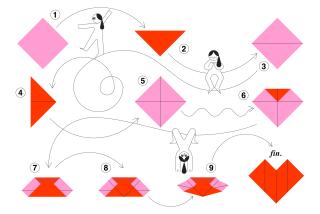Giving Wings to the Peace Movement
ISSAQUAH, Wash. — In the mind of peace advocate Michiko Pumpian, the crane is mightier than the sword -- and, for that matter, more persuasive than protest marches.
The tall, graceful bird is a symbol of peace in her native Japan, and the 48-year-old Pumpian has exported the idea across the globe. For the last decade, she has led the World Peace Project for Children, which promotes peace through the creation of origami cranes.
In 1999, Pumpian got children from around the world to create a crane 120 feet tall and 215 feet wide. All over it were handwritten messages of peace. It was displayed in Seattle’s Kingdome and holds a spot in the Guinness Book of Records.
“When people sit down to make something with their hands, when they work together and think about peace together, they can’t help but become friends,” said Pumpian, who immigrated to Los Angeles in 1981 and later moved to this small town east of Seattle with her husband and three children.
While antiwar demonstrators block intersections a few miles from her home and make speeches on nearby university campuses, Pumpian represents another side of the movement -- one that predates the Iraq war and takes a longer-term and understated approach.
These kinds of organizations, which distinguish themselves by promoting peace rather than opposing war, tend to be overshadowed by more vocal groups during times of conflict. And yet Pumpian and her fellow peace workers say their method accomplishes more change.
Estimates vary on the number of peace groups in this country -- from dozens to hundreds, depending on how the term is defined.
But long-standing organizations devoted exclusively to peace have more effect on citizens because “we exist outside the atmosphere of confrontation,” said Jerry Linscheid of the Mennonite Central Committee, a group based in Akron, Pa.
The committee, founded in 1920, has organized programs that bring Israeli and Palestinian teenagers together on camping trips or teach ministers in Africa about peaceful mediation between warring groups.
The Buddhist Peace Fellowship in Berkeley, in existence for 25 years, encourages members to pray and meditate openly about peace -- usually in silence -- making sure not to disrupt any aspect of the community.
The Atrium Society of Middlebury, Conn., was founded in 1984 and holds workshops on preventing violent conflict on personal and global levels. Like Pumpian’s organization, the society seeks to instill the concept of peace at a young age.
Pumpian traces her preoccupation with peace to her parents, who were in Nagasaki when the United States dropped one of two atomic bombs on Japan to bring an end to World War II. She grew up with stories and images of what the bomb had wrought. She talked of desolated cityscapes, burned children, smoking corpses.
“What war is really about,” she said.
From the horror was born the idea of spreading the message of peace as far as possible. Pumpian said she was especially inspired by the story of one Japanese child, Sadako Sasaki, who died at age 12 from the effects of the bomb.
During her illness, Sadako prayed for recovery and for peace in the world, all the while folding paper cranes through the art of origami. According to Japanese legend, if you fold 1,000 cranes, you get a wish. Sadako died 36 cranes short.
Pumpian has spent the last 10 years making up for Sadako’s shortfall.
With help from supporters in nearly a dozen countries, Pumpian started the World Peace Project for Children, which teaches peace through books, songs and art. She also started the Sadako Peace Club, which brings children from different nations together on projects such as the giant crane.
In the last four years, children from around the globe have sent cranes to Pumpian with messages such as, “Don’t let bombs drop in the world,” and “Peace for everyone.” It’s part of her latest project, One Peace, One Crane. After amassing 1,000, she presents the bouquet of cranes to a peace worker or organization.
Pumpian is a picture of Northwest casual in black sweat pants, a flowered shirt and furry slippers. She is petite, affable, supremely hospitable. She listens carefully and speaks slowly.
She plays the piano and guitar and gives voice lessons to help make ends meet. Musical instruments and books dominate the living room where she runs her peace programs via telephone and e-mail.
She said the war in Iraq makes her “sad,” but quickly added that it isn’t her role to protest. She and other peace advocates, however, recognize the role of protesters.
“They’re important too,” said Bob Lyons of the Buddhist Peace Fellowship. “They’re part of the spectrum. We work on one level, they work on another level.”
On many occasions, the lines between peace advocates and antiwar protesters blur, with one agreeing to work with the other. Pumpian said she’s been contacted by several protest groups, but she has not made up her mind to what extent she wants to get involved in the debate over the war in Iraq.
She said she’s willing, however, to release her giant crane for the purposes of peace -- given the right circumstances.
In a storage shed behind her house sit the rolled-up segments of her world-record bird. There are 640 strips, 3 feet wide and 36 feet long. Four years ago it took hundreds of people, an engineering firm and lots of thick cable to put it together.
The end result was a big bird with a big message.
Ten thousand children wrote messages of peace that were attached to the crane. “And you know,” Pumpian said, when the bird was spread out in the Kingdome, “it gave all those kids an image -- and an idea -- they would never forget.”
More to Read
Sign up for Essential California
The most important California stories and recommendations in your inbox every morning.
You may occasionally receive promotional content from the Los Angeles Times.










